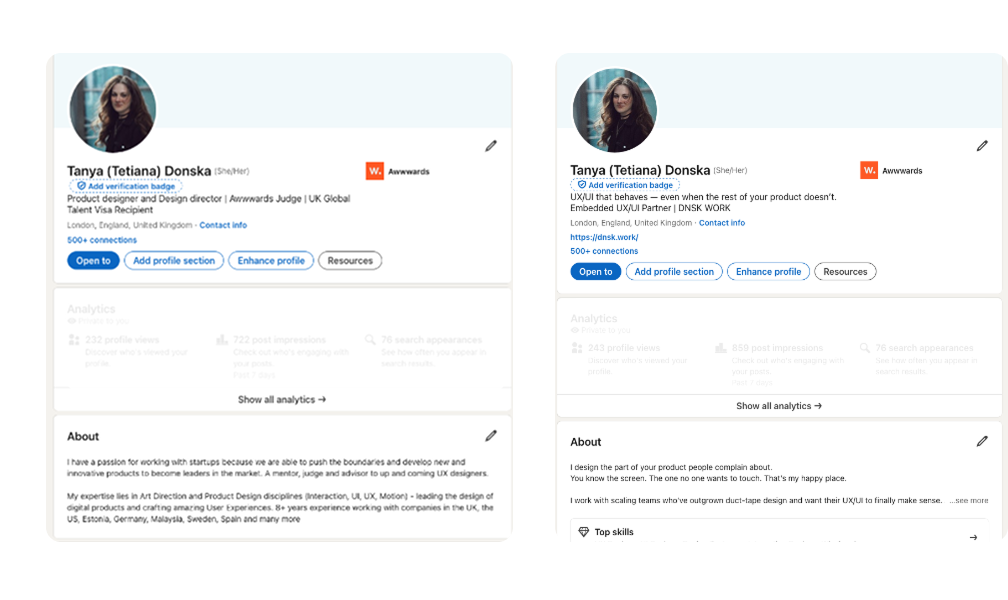Why I Stopped Sounding Like Every Other Designer on LinkedIn
And what happened when I did.
“Award-winning. Passionate. Strategic. Driven.”
You’ve read that sentence before — probably on my old LinkedIn profile.
It wasn’t a lie. But it also wasn’t helping.
I’m a designer. A good one. I’ve led design across enterprise tools, scaling platforms, internal systems, and launch-day MVPs. But you wouldn’t know that from the way I used to talk about myself online. My profile read like it was trying to win a scholarship. Or worse — like I wasn’t sure who I was talking to.
And that’s a problem, especially when you’re part of a small studio trying to attract the right kind of clients.
The Real Problem #
I wasn’t trying to land a full-time job at a bank. I’m not looking to freelance either. What I needed was positioning that reflected how I work now — as a product design partner, embedded in client teams, helping them untangle messy UX and scale their products with intention.
The kinds of clients we work with at DNSK WORK — founders, product leads, startups post-MVP — move quickly and expect clarity. They don’t want a CV. They want to know if you “get it.”
But instead, my old bio opened with:
“An award-winning UI/UX designer with experience in a diverse range of sectors such as tourism, automotive, entertainment, healthtech, fintech…”
Which is the design equivalent of saying: “I like people and enjoy solving problems.” Cool. But not helpful. Not memorable. Not positioning.
These kinds of phrases flood LinkedIn, and most of them are just wallpaper. Vague, repetitive, non-differentiating. Everyone is a “passionate multidisciplinary product thinker.” No one is saying what they actually do, how they work, or why you should care.
Rebuilding the Profile Like a Product #
So I treated myself like a UX problem.
User: startup founder, product lead, possibly overwhelmed and under-supported.
Pain point: too many vague profiles, too many people who say “I do UX/UI” but don’t explain how.
Goal: make them pause, smile, and think, “I’d like to talk to this person.”
Here’s what I changed:
| Before | After |
|---|---|
| “Award-winning UX/UI designer with 8+ years of experience…” | “I design the part of your product people complain about.” |
| “Helping businesses create intuitive digital experiences.” | “You know that screen no one wants to touch? That’s my happy place.” |
| “Focused on clean interfaces and best practices.” | “I design calm — even when your sprint board screams.” |
Each line in the new profile does one thing: it tells the truth, quickly. It doesn’t apologise for being opinionated. It doesn’t try to be for everyone. And it definitely doesn’t sound like ChatGPT on autopilot.
I also stripped the “feature dump” mentality from my experience section. No more listing every task. I chose stories. What was the challenge? What made it messy? What made it fun?
You wouldn’t put lorem ipsum in your UI, so why are you filling your profile with it?
Why It Matters More When You’re Working as a Partner #
When you’re not hiding behind a big-name agency or title, your personal positioning does a lot of heavy lifting. The way you describe yourself is your introduction, your positioning, and your filter — all in one scroll.
At DNSK WORK, we operate more like a product design partner than a service vendor. That means tone matters. Clarity matters. Every line is an invitation — or a red flag.
The goal wasn’t to sound quirky. The goal was to sound like someone worth emailing.
The Subtle Cringe of Sounding Like Everyone Else #
It’s easy to fall into the trap. You read 10 other profiles. You match the tone. You avoid saying anything too specific in case it turns someone off.
But all that does is make you forgettable.
I used to hide behind phrases like “collaborative problem-solver” or “user-focused mindset.” Not because they were wrong — but because they were safe.
Safe doesn’t stand out. And it doesn’t signal confidence.
You can be professional without being vague. You can be credible without being stiff. And you can be memorable without being loud.
A Practical Teardown: What to Kill and What to Keep #
| Kill this | Replace with |
|---|---|
| “I’m passionate about creating user-friendly experiences.” | “I design products people won’t rage-quit.” |
| “Skilled in wireframing, prototyping, design systems…” | “I sketch fast, ship faster, and love cleaning up messy flows.” |
| “I’ve worked across multiple sectors including fintech, healthtech…” | “If your product is messy, that’s where I start.” |
Your LinkedIn isn’t a case study. It’s a first impression. Treat it like one.
Voice Isn’t Fluff — It’s a Filter #
The best copy doesn’t just say what you do. It says who you’re for — and who you’re not.
Voice helps the right people find you. It’s how you attract the clients you actually want, and save yourself the awkward calls with the ones who don’t get it.
Tone is a design decision. Own it.

Final Thoughts #
If your profile reads like it was written by someone trying to please a hiring committee, rewrite it. If it sounds like it could belong to any other designer — rewrite it. If it doesn’t make you smile just a little bit when you read it back — definitely rewrite it.
Say what you actually do. Be clear. Be a little bold. And if you can, be human.
Because nobody wants to hire a buzzword. They want to hire you.
This isn’t a case study. It’s just what happened when I finally stopped overthinking it.